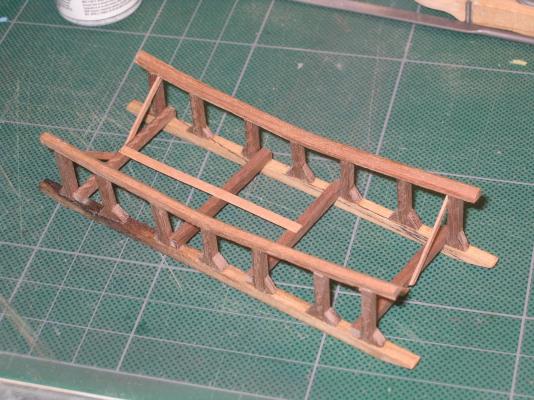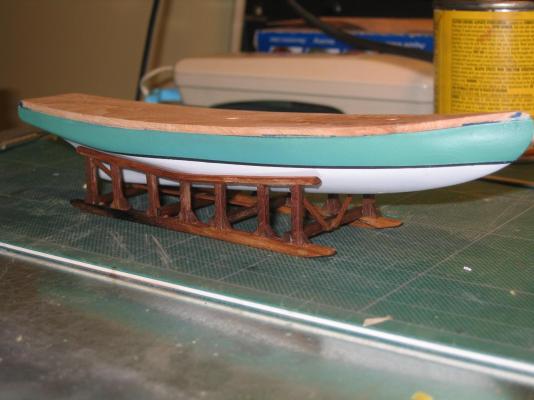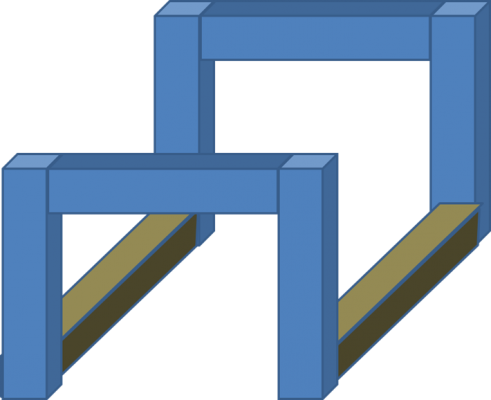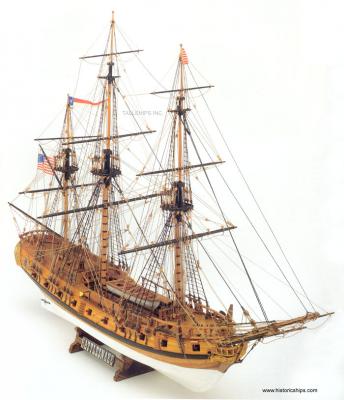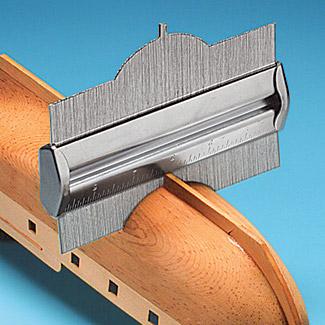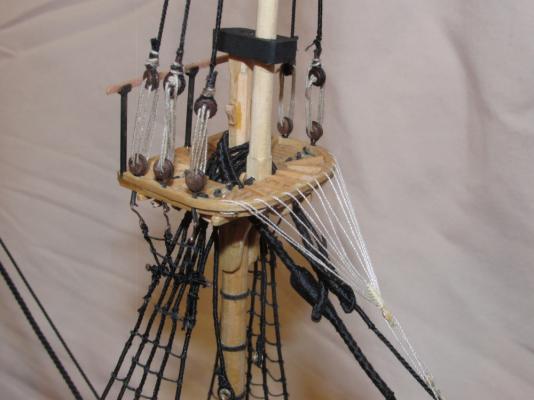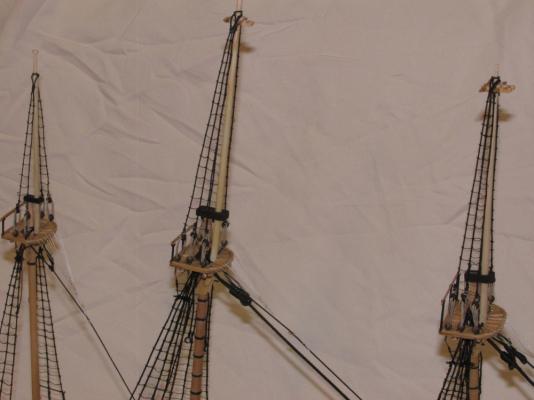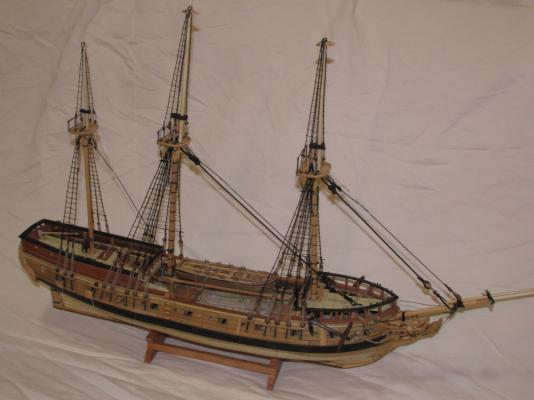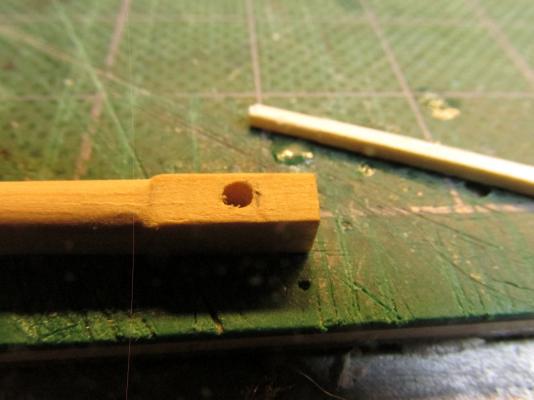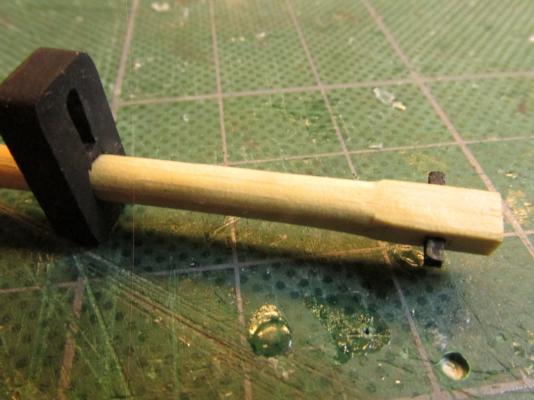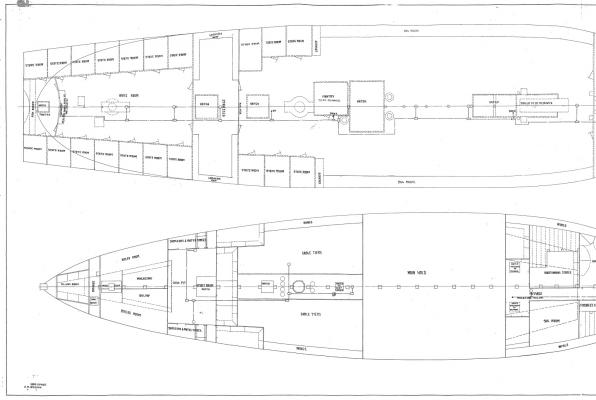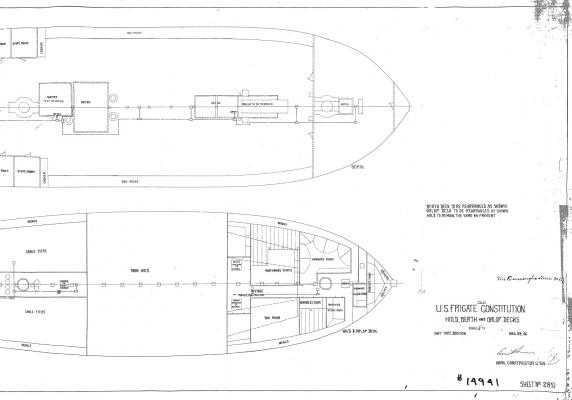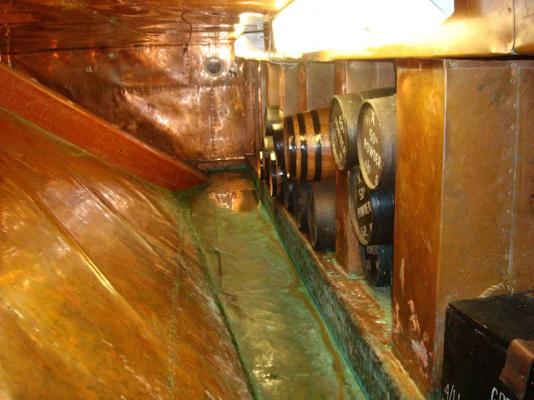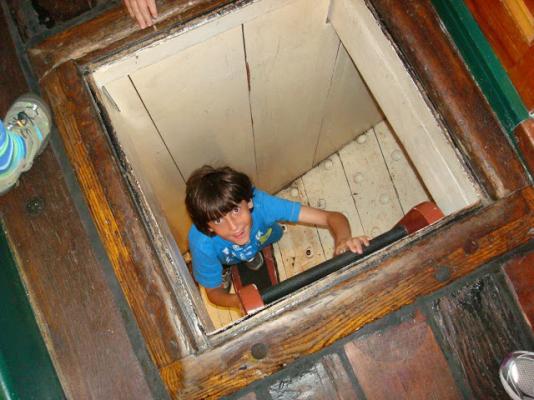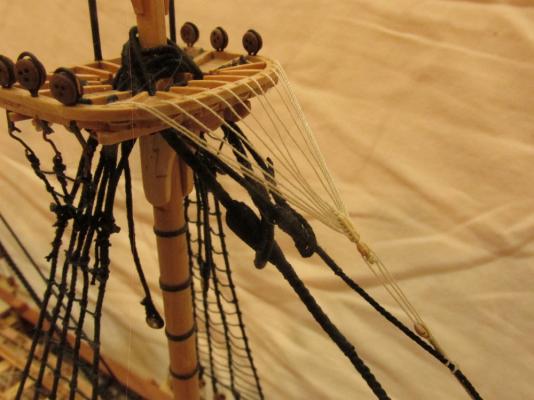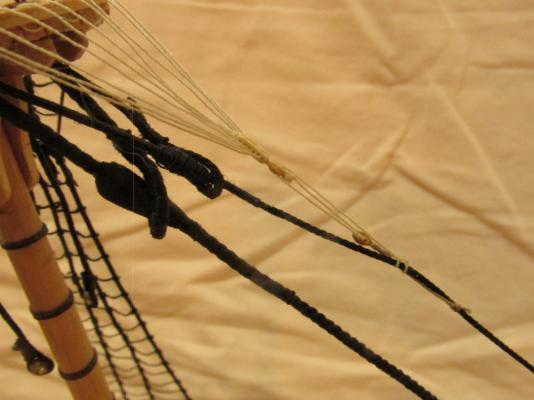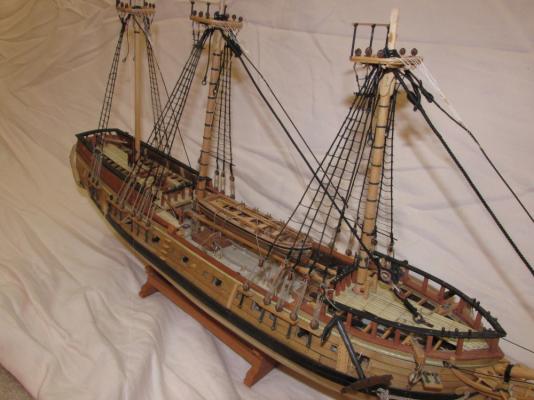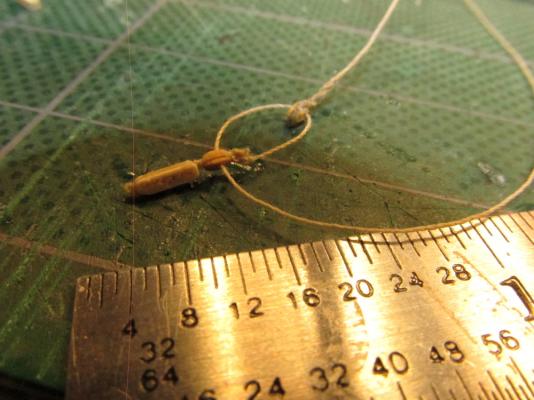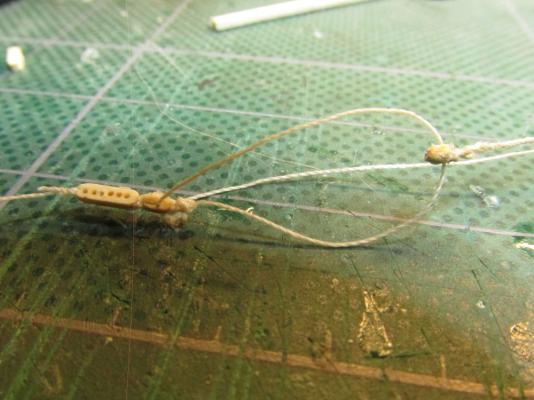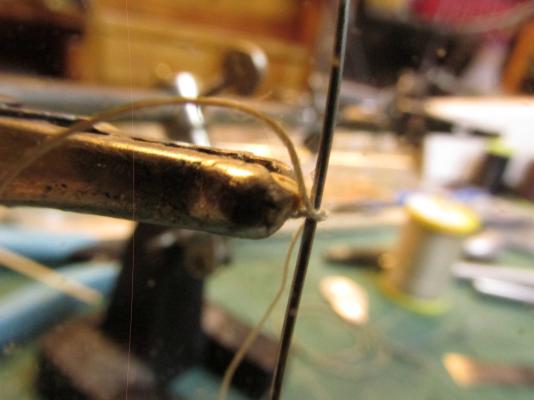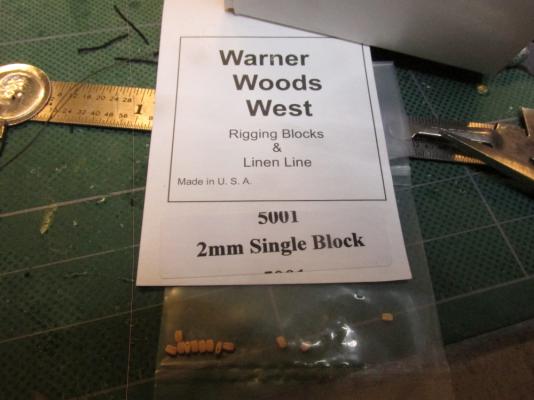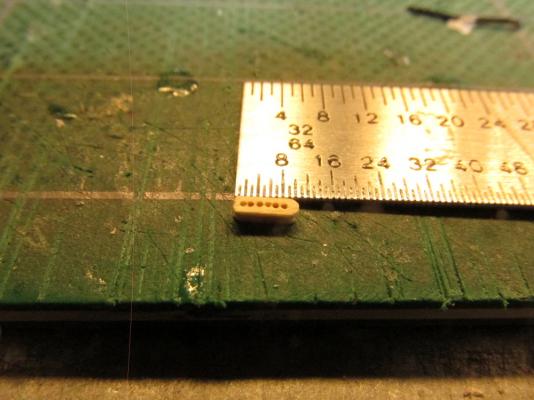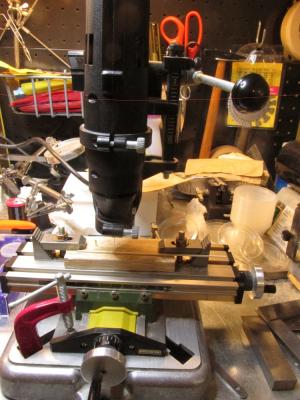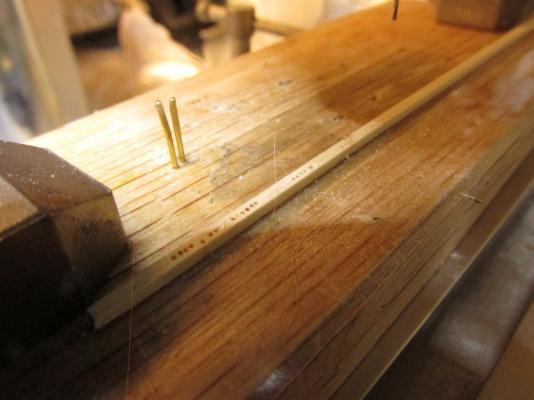-
Posts
2,522 -
Joined
-
Last visited
Content Type
Profiles
Forums
Gallery
Events
Everything posted by JSGerson
-
- 264 replies
-
- rattlesnake
- model shipways
-
(and 1 more)
Tagged with:
-
I think this is what Martin is referring to. Its a crude rendering but with a few added cross supports, taper the top edge, and maybe add a decoration or two, it would be simple to make, no gauge to buy, and most of all, do the job.
- 264 replies
-
- rattlesnake
- model shipways
-
(and 1 more)
Tagged with:
-
I too have my misgivings about those keel pedestals. Unless you built the hull to take the screws from the pedestal and hold them strong, I believe to cradle is the way to go, If you are referring to the type of stand shown in this Mamoli image, a simple way to get the shape of the hull is to use a contour gauge. The one shown is from Micro-Mark. Just transfer the contour to slabs of wood and use a jig-saw.
- 264 replies
-
- rattlesnake
- model shipways
-
(and 1 more)
Tagged with:
-
Thank you for the wonderful mini-tutorial. This is why I love reading your build log. Jonathan
- 277 replies
-
- model shipways
- 18th century longboat
-
(and 1 more)
Tagged with:
-
B.E. thanks for the soldering complement, especially from you. Also thanks for the tip on seizing the stays, it's greatly appreciated. Jonathan
- 974 replies
-
- rattlesnake
- mamoli
-
(and 1 more)
Tagged with:
-
Out of curiosity, how did you get such beautiful consistent square cuts? Are you an expert X-Acto knife user or do you have a specialty tool you used?
- 277 replies
-
- model shipways
- 18th century longboat
-
(and 1 more)
Tagged with:
-
- 974 replies
-
- rattlesnake
- mamoli
-
(and 1 more)
Tagged with:
-
To install the topmasts, the fid needs to be fitted into the masts. Per the practicum, Mr. Hunt simple glued square piece of ebony to simulate the fid. I chose to actual put them through the masts to ensure a good mechanical joint. It wouldn’t do well for the simulated fib’s glue joint to fail due to the tension of all the lines. It would be a mess to fix. Since I didn’t have any ebony, painted boxwood was used. I made sure that the fid was no more than 1/3 the width of the top mast. You may notice that the fid is square in cross section and the hole is round. Here is a case where one does fit a square peg in a round hole! The very slight gap between the fids and the holes vanishes unless one uses a very strong magnifying glass and even then it’s hard to see.
- 974 replies
-
- rattlesnake
- mamoli
-
(and 1 more)
Tagged with:
-
I traded some Constitution plan images with DanO recently and found this 1906 plan drawing of the Orlop deck in the images he sent me. They were larger than the site would allow, so I've re-sized them to the max the site does allow. I don't know if you have it, but you got now.
- 572 replies
-
- constitution
- frigate
-
(and 1 more)
Tagged with:
-
From: A Sailor's Life for Me (an educational site for young minds) I thought the illustration might be of some use...maybe.
- 572 replies
-
- constitution
- frigate
-
(and 1 more)
Tagged with:
-
Mine predates yours. Have have model 212...sigh 8-(
- 277 replies
-
- model shipways
- 18th century longboat
-
(and 1 more)
Tagged with:
-
Like I said, I have an older version Dremel drill stand. Nothing rotates; you have to slide the head completely off the vertical pole and re-attach it in the horizontal position using a different opening in the head. I guess that's why they made a newer version. 8-(
- 277 replies
-
- model shipways
- 18th century longboat
-
(and 1 more)
Tagged with:
-
I have an older version of the Dremel drill press than you and it only has two positions: vertical and horizontal. Obviously you were able to rotate your drill 45 degrees. After going online and looking at the newer Dremel drill press, I still can't see the mechanism that allowed you to set the drill to 45 degrees. Is there something I don't know?
- 277 replies
-
- model shipways
- 18th century longboat
-
(and 1 more)
Tagged with:
-
Found these images of the powder room. I didn't know if you had them. The first one is the powder room the second is the scuttle to it. You will notice the room is copper clad which should add some interest to your model. I assume that the cladding prevents static charges so things don't go bump in the night. Jonathan
- 572 replies
-
- constitution
- frigate
-
(and 1 more)
Tagged with:
-
I ran across this US Navy file I collected some time ago about the mystery pump (discussion started in post #248): ConstitutionPumps.pdf It confirms that it was a fresh water pump and dates back to the 1870's. Unfortunately, now I cannot find the website source I got it from.
- 572 replies
-
- constitution
- frigate
-
(and 1 more)
Tagged with:
-
Dan - Nope, I don't have Nos., 24402 or 24403 on the CD. I even have a bunch of plans I downloaded from the US Navy (but can't seem to find their internet source now) and there not listed there either. If I find the Navy source again I'll let everyone know. If you can find your source who knows what else is there? Jonathan
- 572 replies
-
- constitution
- frigate
-
(and 1 more)
Tagged with:
-
Dan - I have the CD from the Constitution Museum Store you describe but I can't find anything labeled: 'Drainage, Flooding, Fresh Water, and sanitary piping" or '0930 Orlop' or '0929 Berth' or '0928 Gun.' Are you sure it came off that CD and not something else? I plan sometime in the future to build my own Conny model once my Rattlesnake build is done. I'm gathering all my research material now so when I'm ready to build, I won't have that excuse not to start. Jonathan
- 572 replies
-
- constitution
- frigate
-
(and 1 more)
Tagged with:
-
It's a thought, but I'll try adjusting the line first. I do have a supply of music (piano) wire in a variety of sizes.
- 974 replies
-
- rattlesnake
- mamoli
-
(and 1 more)
Tagged with:
-
GuntherMT - I did notice the alignment change. The problem I had, was that the stays are not very taught so any line attached to them is going to tug on it. I'll try to readjust them to reduce the obvious kink in the stays. Thanks for keeping an eye out for me. Jonathan
- 974 replies
-
- rattlesnake
- mamoli
-
(and 1 more)
Tagged with:
-
Now it was just a matter of weaving the lines to make the crowsfeet and securing the euphroes to the stays.
- 974 replies
-
- rattlesnake
- mamoli
-
(and 1 more)
Tagged with:
-
After the second block was fashioned, the pieces were assembled. The lines for the crowsfeet were made long to ensure there was enough when it was rigged to the model.
- 974 replies
-
- rattlesnake
- mamoli
-
(and 1 more)
Tagged with:
-
Once the block was attached, it too needed a loop so a line could be attached and fastened to a block attached to the stay. The loops at both ends were made using a piece of wire to form the loop opening.
- 974 replies
-
- rattlesnake
- mamoli
-
(and 1 more)
Tagged with:
-
Assembly At one end of the euphroe is a small loop used to attach the center crowsfoot line. At the other, a four inch block needed to be attached. A four inch block works out to 0.0625” or 1.59mm. The smallest block I have seen/used is one made by Warner Woods West (warwoods@infowest.com) at 2mm. I was using his blocks before Chuck Passaro’s Syren Ship Model Company started selling theirs. However, Syren’s 2 mm are a bit bigger than Warner Woods’. Luckily, I had some leftover from my Evergreen build.
- 974 replies
-
- rattlesnake
- mamoli
-
(and 1 more)
Tagged with:
-
The pieces were cut off the strip and the ends rounded. A groove was filed along the length of the euphroes for the rope stroping.
- 974 replies
-
- rattlesnake
- mamoli
-
(and 1 more)
Tagged with:
-
Euphroe The euphroe is a special type of “block” which gathers the lines coming off of the mast top. In my case, at 1:64 scale, it worked out to about 3/16” in length. According to Sproul, there was no universal shape used. He provided different examples from oval to egg to straight with various cross sections. At this scale I stuck with the very basic – straight with rounded ends. I started with a strip of 3/64” square boxwood which I mounted on my rotary drill press stand equipped with an X-Y table. After numerous fiddlings and adjustments with the table to get the wood strip lined up with the table, I used a #78 drill to drill 6 holes for the main and fore masts and 5 holes for the mizzen mast euphroes. I am amazed that I got what I did. The drill press stand is not ridged. Moving the drill up and down with the lever, has a minute lateral movement. To make matters worse, the drill (a product of Sears not Dremel) does not spin exactly on it center axis so it has a minute wobble. One of these years I’ll get a proper drill press…someday.
- 974 replies
-
- rattlesnake
- mamoli
-
(and 1 more)
Tagged with:
About us
Modelshipworld - Advancing Ship Modeling through Research
SSL Secured
Your security is important for us so this Website is SSL-Secured
NRG Mailing Address
Nautical Research Guild
237 South Lincoln Street
Westmont IL, 60559-1917
Model Ship World ® and the MSW logo are Registered Trademarks, and belong to the Nautical Research Guild (United States Patent and Trademark Office: No. 6,929,264 & No. 6,929,274, registered Dec. 20, 2022)
Helpful Links
About the NRG
If you enjoy building ship models that are historically accurate as well as beautiful, then The Nautical Research Guild (NRG) is just right for you.
The Guild is a non-profit educational organization whose mission is to “Advance Ship Modeling Through Research”. We provide support to our members in their efforts to raise the quality of their model ships.
The Nautical Research Guild has published our world-renowned quarterly magazine, The Nautical Research Journal, since 1955. The pages of the Journal are full of articles by accomplished ship modelers who show you how they create those exquisite details on their models, and by maritime historians who show you the correct details to build. The Journal is available in both print and digital editions. Go to the NRG web site (www.thenrg.org) to download a complimentary digital copy of the Journal. The NRG also publishes plan sets, books and compilations of back issues of the Journal and the former Ships in Scale and Model Ship Builder magazines.



